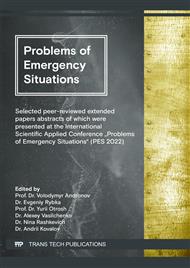[1]
S. Bourbigot, Flame retardancy of textiles: new approaches Advances in fire retardant materials woodhead publishing series in textiles. (2008) 9-40.
DOI: 10.1533/9781845694701.1.9
Google Scholar
[2]
N. Yaman, Preparation and flammability properties of hybrid materials containing phosphorous compounds via sol–gel process. Fibers and Polymers. 10(4) (2009) 413-418.
DOI: 10.1007/s12221-009-0413-1
Google Scholar
[3]
G. Brancatelli, C. Colleoni, M.R. Massafra, G. Rosace, Effect of hybrid phosphorus-doped silica thin films produced by sol–gel method on the thermal behavior of cotton fabrics. Polymer Degradation and Stability, 96(4) (2011) 483-490.
DOI: 10.1016/j.polymdegradstab.2011.01.013
Google Scholar
[4]
J. Alongi, M. Ciobanu, F. Carosio, J. Tata, G. Malucelli, Thermal stabilityand flame retardancy of polyester, cotton and relative blend textilefabrics treated by sol–gel process. Journal of Applied Polymer Science, 119 (2011)1961-1969.
DOI: 10.1002/app.32954
Google Scholar
[5]
J. Tata, J. Alongi, F. Carosio, A. Frache, Optimization of the procedure to burn textile fabrics by cone calorimeter: part I. Combustion behavior of polyester. Fire and Materials, 35 (2011) 397-409.
DOI: 10.1002/fam.1061
Google Scholar
[6]
O. Skorodumova, O. Tarakhno, O. Chebotaryova, D. Saveliev, F.M. Emen, Investigation of gas formation processes in cotton fabrics impregnated with binary compositions of ethyl silicate-flame retardant system. Materials Science Forum, 1038 (2021) 460-467.
DOI: 10.4028/www.scientific.net/msf.1038.460
Google Scholar
[7]
V. Andronov, Y. Danchenko, Y. Makarov, T. Obizhenko, Colloid-chemical regularities of reagent wastewater treatment of dairies. Materials Science Forum, 1038 (2021) 235-241.
DOI: 10.4028/www.scientific.net/msf.1038.235
Google Scholar
[8]
V. Loboichenko, V. Andronov, V. Strelets, O. Oliinykov, M. Romaniak, Study of the State of Water Bodies Located within Kharkiv City (Ukraine). Asian Journal of Water, Environment and Pollution, 17(2) (2020) 15-21.
DOI: 10.3233/ajw200015
Google Scholar
[9]
J-W. Kim, T. Isobe, M. Muto, N.M. Tue, K. Ktsura, G. Malarvannan, A. Sudaryanto, K-H. Chang, M. Prudente, P.H. Viet, S. Takahashi, S. Tanabe, Organophosphorus flame retardants (PFRs) in human breast milk from several Asian countries. Chemosphere, 116 (2014) 91-97.
DOI: 10.1016/j.chemosphere.2014.02.033
Google Scholar
[10]
O. Skorodumova, O. Tarakhno, O. Chebotaryova, O. Bezuglov, F.M. Emen, The use of sol-gel method for obtaining fire-resistant elastic coatings on cotton fabrics. Materials Science Forum, 1038 (2021) 468-479.
DOI: 10.4028/www.scientific.net/msf.1038.468
Google Scholar
[11]
B. Pospelov, V. Andronov, E. Rybka, K. Karpets, E. Kochanov, Development of The Method of Operational Forecasting of Fire in the Premises of Objects Under Real Conditions Eastern-European Journal of Enterprise Technologiesthis link is disabled, 2 (2021) 43-50.
DOI: 10.15587/1729-4061.2021.226692
Google Scholar
[12]
A. Chernukha, A. Teslenko, P. Kovaliov, O. Bezuglov, Mathematical Modeling of Fire-Proof Efficiency of Coatings Based on Silicate Composition. Materials Science Forum, 1006 (2020) 70-75.
DOI: 10.4028/www.scientific.net/msf.1006.70
Google Scholar
[13]
Pospelov B., Meleshchenko R., Krainiukov O., Karpets K., Petukhova O., Bezuhla Y., Butenko T., Horinova V., Borodych P., Kochanov E. A method for preventing the emergency resulting from fires in the premises through operative control over a gas medium. Eastern-European Journal of Enterprise Technologies, 10–103 (2020) 6–13.
DOI: 10.15587/1729-4061.2020.194009
Google Scholar
[14]
Skorodumova, O., Tarakhno, O., Chebotaryova, O., Hapon, Y., Emen, F.M. Formation of fire retardant properties in elastic silica coatings for textile materials. Materials Science Forum, 1006 (2020) 25-31.
DOI: 10.4028/www.scientific.net/msf.1006.25
Google Scholar
[15]
B. Pospelov, E. Rybka, R. Meleshchenko, S. Gornostal, S. Shcherbak, Results of experimental research into correlations between hazardous factors of ignition of materials in premises. Eastern-European Journal of Enterprise Technologies, 6 10 90 (2017) 50–56.
DOI: 10.15587/1729-4061.2017.117789
Google Scholar
[16]
S. Vambol, V. Vambol, I. Bogdanov, Y. Suchikova, N. Rashkevich, Research of the influence of decomposition of wastes of polymers with nano inclusions on the atmosphere. Eastern-European Journal of Enterprise Technologies, 6 10–90 (2017) 57–64.
DOI: 10.15587/1729-4061.2017.118213
Google Scholar
[17]
V. Andronov, B. Pospelov, E. Rybka, Development of a method to improve the performance speed of maximal fire detectors. Eastern-European Journal of Enterprise Technologies, 2 9 86 (2017) 32–37.
DOI: 10.15587/1729-4061.2017.96694
Google Scholar
[18]
V. Sadkovyi, B. Pospelov, V. Andronov, E. Rybka, O. Krainiukov, А. Rud, K. Karpets, Yu. Bezuhla, Construction of a method for detecting arbitrary hazard pollutants in the atmospheric air based on the structural function of the current pollutant concentrations. Eastern-European Journal of Enterprise. 6/10 (108) (2020)14-22.
DOI: 10.15587/1729-4061.2020.218714
Google Scholar
[19]
B. Pospelov, V. Andronov, E. Rybka, V. Popov, A. Romin, Experimental study of the fluctuations of gas medium parameters as early signs of fire. Eastern-European Journal of Enterprise Technologies, 1 10 91 (2018) 50–55.
DOI: 10.15587/1729-4061.2018.122419
Google Scholar
[20]
B. Pospelov, V. Andronov, E. Rybka, S. Skliarov, Research into dynamics of setting the threshold and a probability of ignition detection by selfadjusting fire detectors. Eastern-European Journal of Enterprise Technologies, 5/9 89 (2017) 43–48.
DOI: 10.15587/1729-4061.2017.110092
Google Scholar
[21]
Popov, O., Iatsyshyn, A., Sokolov, D., Dement, M., Neklonskyi, I., Yelizarov, A.Terms and conditions Privacy policy Application of virtual and augmented reality at nuclear power plants. Studies in Systems, Decision and Control, 346 (2021) 243-260.
DOI: 10.1007/978-3-030-69189-9_14
Google Scholar
[22]
B. Pospelov, V. Andronov, E. Rybka, S. Skliarov, Design of fire detectors capable of self-adjusting by ignition. Eastern-European Journal of Enterprise Technologies, 4 9 88 (2017) 53–59.
DOI: 10.15587/1729-4061.2017.108448
Google Scholar
[23]
B. Pospelov, V. Andronov, E. Rybka, M. Samoilov, O. Krainiukov, I. Biryukov, T. Butenko, Yu. Bezuhla, K. Karpets, E. Kochanov, Development of the method of operational forecasting of fire in the premises of objects under real conditions. Eastern-European Journal of Enterprise, 2/10 110 (2021) 43–50.
DOI: 10.15587/1729-4061.2021.226692
Google Scholar
[24]
Kustov M., Slepuzhnikov E., Lipovoy V., Khmyrov I., Firdovsi D., Buskin O. Procedure for implementation of the method of artificial deposition of radioactive substances from the atmosphere. Nuclear and Radiation Safety, 3 83 (2019) 13–25.
DOI: 10.32918/nrs.2019.3(83).02
Google Scholar



